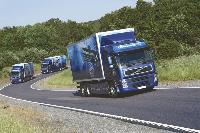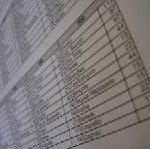The Volvo Group is the first vehicle manufacturer to produce seven demonstration trucks that can all be driven without emitting any environmentally harmful carbon dioxide. These trucks were exhibited for the first time today in Stockholm and are equipped with diesel engines that have been modified to operate on seven different types of renewable liquid and gaseous fuels.
Part of the solution
“As one of the world’s largest manufacturers of heavy trucks, diesel engines and buses, the Volvo Group is part of the climate problem,” says Leif Johansson, CEO of Volvo. “But environmental issues are one of the areas which we have assigned the very highest priority, and based on our resources and knowledge, we both can and will be part of the solution.”
The seven trucks exhibited in Stockholm can be operated on the same number of different renewable fuels and/or combinations of fuels: biodiesel, biogas combined with biodiesel, ethanol/methanol, DME, synthetic diesel and hydrogen gas combined with biogas. Since all of these fuels are produced from renewable raw materials, they provide no carbon-dioxide contributions to the ecosystem when combusted and, accordingly, do not impact the environment.
“The diesel engine is an extremely efficient energy converter that is perfectly suited to many different renewable fuels, liquid or gaseous,” says Jan-Eric Sundgren, member of Volvo Group Management and Senior Vice President, Public and Environmental Affairs. “With our know-how in engine technology and our large volumes, we can manufacture engines for several different renewable fuels, and also create possibilities for carbon-dioxide-free transports in such other product areas as buses, construction equipment and boats.”
Volvo is ready
However, the supply of different renewable fuels is significantly limited and there is no large-scale production or distribution for the majority of the alternatives that could be utilized in carbon-dioxide-free transports.
“With these vehicles, we have shown that Volvo is ready, that we possess the technology and the resources for carbon-dioxide-free transport, but we cannot do this alone,” says Leif Johansson. “We also require large-scale production of renewable fuels and putting such production in operation requires extensive investments in research and development, and also well-defined, common guidelines from authorities in as many countries as possible.”
Own analyses of fuels
Volvo has carried out its own analyses of the renewable fuels that are most suitable for carbon-dioxide-free transports. In these analyses, Volvo considered important aspects such as the impact on the environment, energy efficiency, the efficiency level in the use of the land for cultivating crops for the respective fuels, the amounts of the different fuels that can potentially be produced, the level of vehicle adaptation required in purely technical terms, the costs of the fuels and how easy it is to distribute the fuels.
“We know that in the foreseeable future there will be insufficient biomass or renewable fuels to fully replace fossil fuels,” says Jan-Eric Sundgren. “That is why it is important that decisions on the production of future fuels are preceded by such comprehensive assessments – otherwise there is the risk that we focus on too many and quite simply unsuitable alternatives, which will delay the introduction of carbon-dioxide-free transport.”
Promising results from gasification
Despite the current shortage of both biomass for the production of renewable fuels, and finished fuels, the Volvo Group does not view carbon-dioxide-free transport as a utopian idea. One of the reasons for this is the second generation of renewable fuels that are produced through gasification and that generate both large volumes and a greater number of fuels to choose between.
“Gasification is a promising line that may lead to a significantly larger substitution than today’s technology,” says Leif Johansson. “Our own history has taught us that much of what we once thought impossible we have since been able to solve a few years later. This can be applied to such important areas as energy efficiency and exhaust emission control. I am an optimist and believe in a similar trend in carbon-dioxide-free transport.”
Seven different cars – seven different fuels
The trucks exhibited in Stockholm were operated on the seven following renewable fuels/fuel combinations:
Biodiesel
Biodiesel is produced by the esterification of vegetable oils. Rapeseed oil and sunflower seed oil are the most common raw materials in Europe.
Biogas
Biogas is a gaseous fuel that is largely comprised of hydrocarboned methane. Biogas can be extracted in sewage treatment works, at garbage dumps, and at other sites at which biodegradable materials are found.
Biogas + biodiesel
Biogas + biodiesel are combined in separate tanks and injection systems. A small percentage (10 percent) of biodiesel, or synthetic diesel, is used for achieving compression ignition. The biogas in this alternative is in a cooled and liquid form that increases its range.
DME – Dimethyl ether
Dimethyl ether is a gas that is handled in liquid form under low pressure. DME is produced through the gasification of biomass.
Ethanol/Methanol
Methanol is produced through the gasification of biomass and ethanol through the fermentation of crops rich in sugar and starch.
Synthetic Diesel
Synthetic Diesel is a mixture of synthetically manufactured hydrocarbon produced through the gasification of biomass. Synthetic diesel can be mixed with conventional diesel fuel without problem.
Hydrogen gas + Biogas
This vehicle operates on a combination of hydrogen gas and biogas whereby the hydrogen gas is mixed in small volumes with compressed biogas (8% volume). Higher mixture levels are also possible. The hydrogen gas can be produced through the gasification of biomass or electrolysis of water with renewable electricity.
















